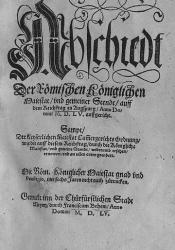Peace of Augsburg
Signed on September 25, 1555, the Peace of Augsburg was an agreement between the Holy Roman Emperor Charles V and an alliance of Lutheran princes that paved the way for greater religious freedom in Western Europe. The treaty allowed for the prince of each state within the Holy Roman Empire to decide on either Lutheranism or Roman Catholicism as the official religion in the domain over which he reigned. Under the treaty, the citizens and subjects of a given state—upon the declaration of the official religion within said state—who were not in agreement with the announced religion were provided a grace period in which they could relocate to a place where they could practice freely their desired religion. Not only did this paradigm shift convey the Catholic Church in a less absolutist light, but it also highlighted a trend toward a belief in the importance of the individual and of his preferences in religious observance.
(Image Source: Unknown [Public Domain], via Wikimedia Commons, https://commons.wikimedia.org/w/index.php?curid=533576)

